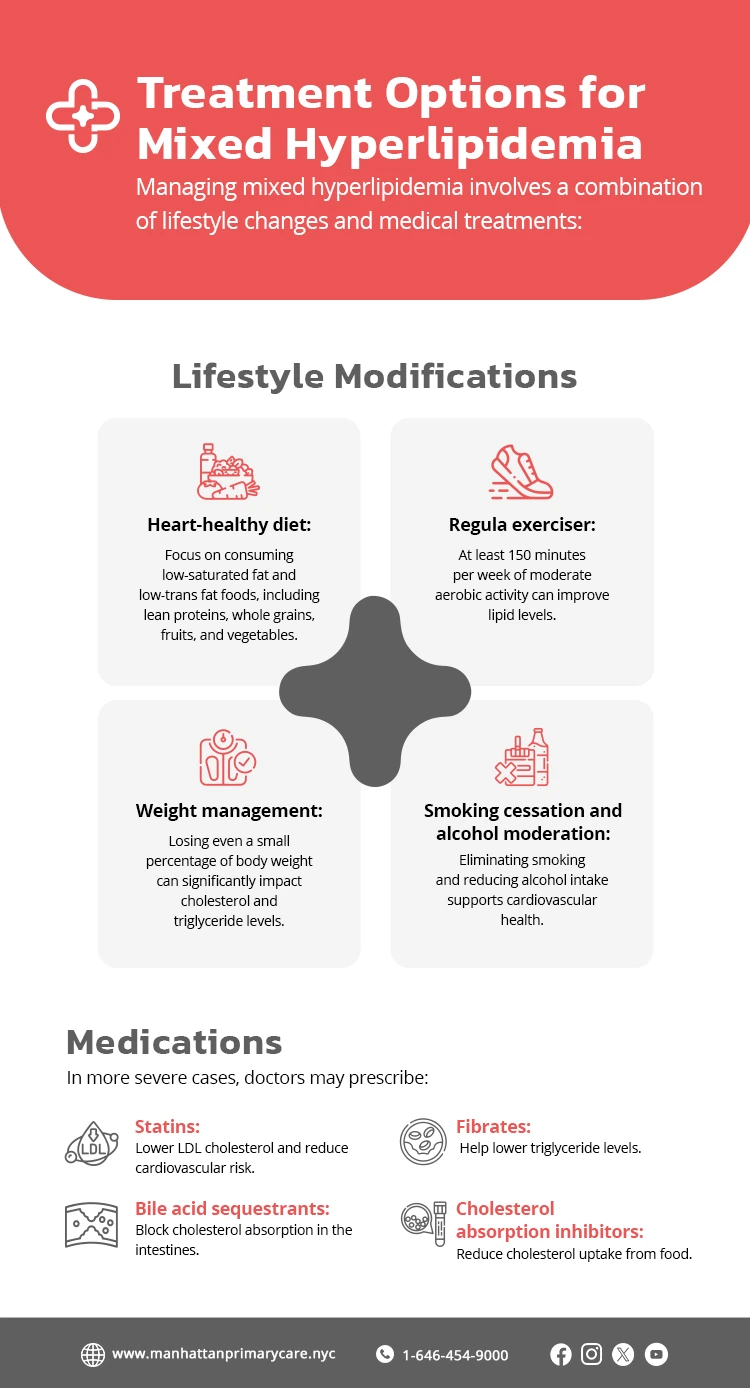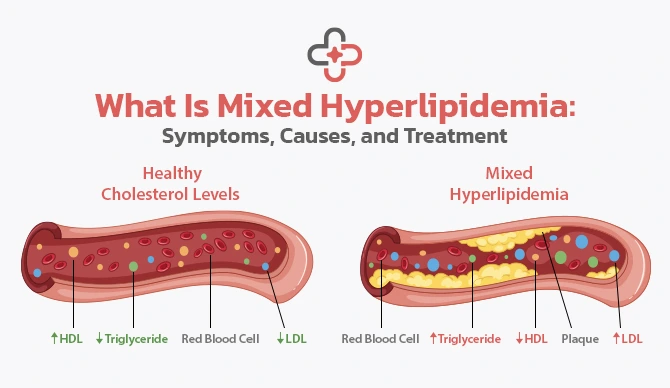Mixed hyperlipidemia is a common yet often overlooked lipid disorder characterized by elevated levels of cholesterol and triglycerides. It significantly increases the risk of cardiovascular diseases, including coronary artery disease, stroke, and heart attacks. Understanding its causes, symptoms, and management strategies is crucial for maintaining heart health and preventing long-term complications.
Understanding the Basics of Mixed Hyperlipidemia
Mixed hyperlipidemia is a metabolic disorder that leads to high levels of low-density lipoprotein (LDL) cholesterol, triglycerides, and, in some cases, decreased high-density lipoprotein (HDL) cholesterol. This condition can be inherited, known as familial combined hyperlipidemia (FCHL), or develop due to lifestyle factors, metabolic disorders, or underlying health conditions.
Unlike primary hyperlipidemia, which is caused solely by genetic factors, mixed hyperlipidemia results from a combination of genetic predisposition and lifestyle influences, making its management more complex.
Symptoms of Mixed Hyperlipidemia
Mixed hyperlipidemia is often asymptomatic in its early stages, making regular screening essential. However, in advanced cases, symptoms may include:
- Xanthomas: Fatty deposits under the skin, typically on the elbows, knees, or eyelids.
- Chest pain or angina: Caused by narrowed arteries due to excess lipid buildup.
- Leg pain or cramping: Particularly during physical activity due to poor circulation.
- Frequent numbness or tingling: Especially in the extremities.
- Early heart attacks or strokes: More common in individuals with a strong family history of high cholesterol or cardiovascular disease.
Diagnosis: How is Mixed Hyperlipidemia Identified?
Diagnosis is typically based on blood tests that measure:
- Total cholesterol
- LDL (low-density lipoprotein) cholesterol
- HDL (high-density lipoprotein) cholesterol
- Triglyceride levels
Healthcare professionals may also consider factors such as family history, lifestyle habits, and the presence of other metabolic disorders (e.g., diabetes mellitus, obesity, or metabolic syndrome).
Causes and Risk Factors of Mixed Hyperlipidemia
Mixed hyperlipidemia is influenced by both genetic and lifestyle factors. Common causes and risk factors include:
- Genetics: Inherited conditions such as familial combined hyperlipidemia (FCHL) can increase lipid levels at an early age.
- Unhealthy diet: Consuming excessive saturated fats, trans fats, and processed foods contributes to elevated cholesterol and triglyceride levels.
- Obesity: Being overweight can lead to lipid imbalances and insulin resistance.
- Sedentary lifestyle: Lack of physical activity affects lipid metabolism and increases cardiovascular risk.
- Diabetes mellitus: Poor blood sugar control can exacerbate high cholesterol and triglyceride levels.
- Smoking and excessive alcohol consumption: Both can lower HDL cholesterol while increasing LDL cholesterol and triglycerides.
The Role of Genetics in Mixed Hyperlipidemia
Genetics plays a significant role in mixed hyperlipidemia, particularly in individuals with familial combined hyperlipidemia (FCHL). This inherited disorder causes abnormal lipid metabolism, leading to excessive production of LDL cholesterol and triglycerides. Individuals with a family history of early heart disease, stroke, or high cholesterol should undergo regular lipid screenings and adopt heart-healthy habits early on.
Treatment Options for Mixed Hyperlipidemia
Managing mixed hyperlipidemia involves a combination of lifestyle changes and medical treatments:


Lifestyle Modifications
- Heart-healthy diet: Focus on consuming low-saturated fat and low-trans fat foods, including lean proteins, whole grains, fruits, and vegetables.
- Regular exercise: At least 150 minutes per week of moderate aerobic activity can improve lipid levels.
- Weight management: Losing even a small percentage of body weight can significantly impact cholesterol and triglyceride levels.
- Smoking cessation and alcohol moderation: Eliminating smoking and reducing alcohol intake supports cardiovascular health.
Medications
In more severe cases, doctors may prescribe:
- Statins: Lower LDL cholesterol and reduce cardiovascular risk.
- Fibrates: Help lower triglyceride levels.
- Bile acid sequestrants: Block cholesterol absorption in the intestines.
- Cholesterol absorption inhibitors: Reduce cholesterol uptake from food.
Complications and Side Effects of Mixed Hyperlipidemia
If left untreated, mixed hyperlipidemia can lead to serious complications such as:
- Coronary artery disease (CAD): Narrowed arteries increase the risk of heart attacks.
- Stroke: Due to plaque buildup in blood vessels.
- Peripheral artery disease (PAD): Poor circulation leading to leg pain and potential limb amputation.
- Pancreatitis: Extremely high triglyceride levels can cause inflammation of the pancreas.
Mixed Hyperlipidemia and Life Expectancy
Life expectancy for individuals with mixed hyperlipidemia varies based on how well the condition is managed. Early detection, lifestyle changes, and medical treatment can significantly reduce the risk of cardiovascular events and prolong life. Without proper management, the risk of premature heart disease and stroke increases.
Is Mixed Hyperlipidemia Serious?
Yes, mixed hyperlipidemia is a serious condition as it greatly increases the risk of cardiovascular diseases, heart attacks, and strokes. However, with appropriate lifestyle modifications, medications, and routine monitoring, individuals can effectively manage their lipid levels and maintain good overall health.
Conclusion
Mixed hyperlipidemia is a complex but manageable condition that requires proactive health management. Regular screenings, a heart-healthy diet, exercise, and medical treatment when necessary can help control lipid levels and prevent life-threatening complications. If you have a family history of high cholesterol or experience symptoms, Consult a primary care service professional for guidance on developing a personalized treatment plan and reducing your cardiovascular risk.
Frequently Asked Questions
Can lifestyle changes help manage mixed hyperlipidemia?
Yes, a healthy diet, regular exercise, weight management, and quitting smoking can help lower cholesterol and triglyceride levels.
How common is mixed hyperlipidemia?
It is fairly common, especially in individuals with genetic predisposition, obesity, or metabolic disorders like diabetes.
How can I prevent mixed hyperlipidemia?
Maintain a balanced diet, exercise regularly, avoid smoking, limit alcohol intake, and get routine cholesterol checks.
Are there any natural remedies for mixed hyperlipidemia?
Omega-3 fatty acids, fiber-rich foods, plant sterols, and niacin may help, but consult a doctor before using supplements.
What is the difference between mixed hyperlipidemia and hyperlipidemia?
Hyperlipidemia refers to high lipid levels in general, while mixed hyperlipidemia involves elevated LDL cholesterol, triglycerides, and often low HDL cholesterol.
How often should lipid levels be checked if I have mixed hyperlipidemia?
Typically every 6 to 12 months, depending on your risk factors and doctor’s recommendations.
Disclaimer
This blog is for informational & educational purposes only and does not intend to substitute any professional medical advice or consultation. For any health-related concerns, please consult with your physician, or call 911.
